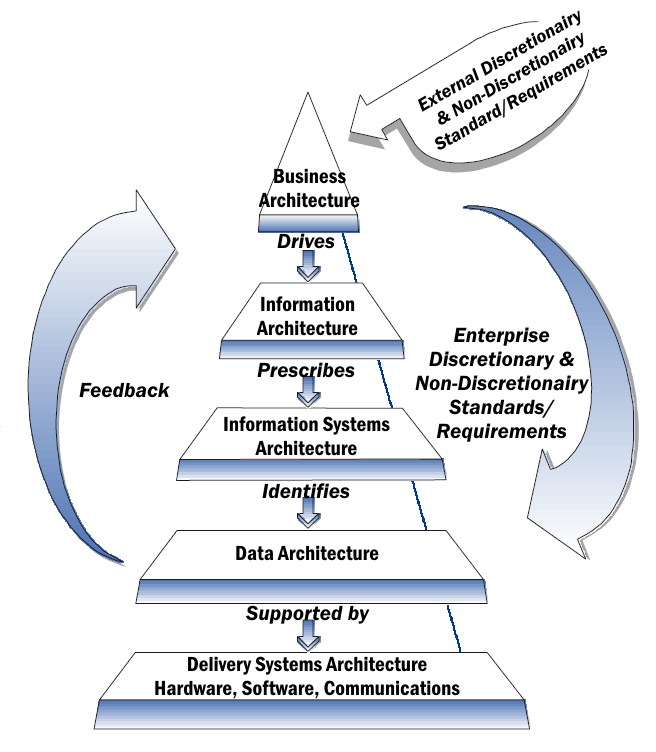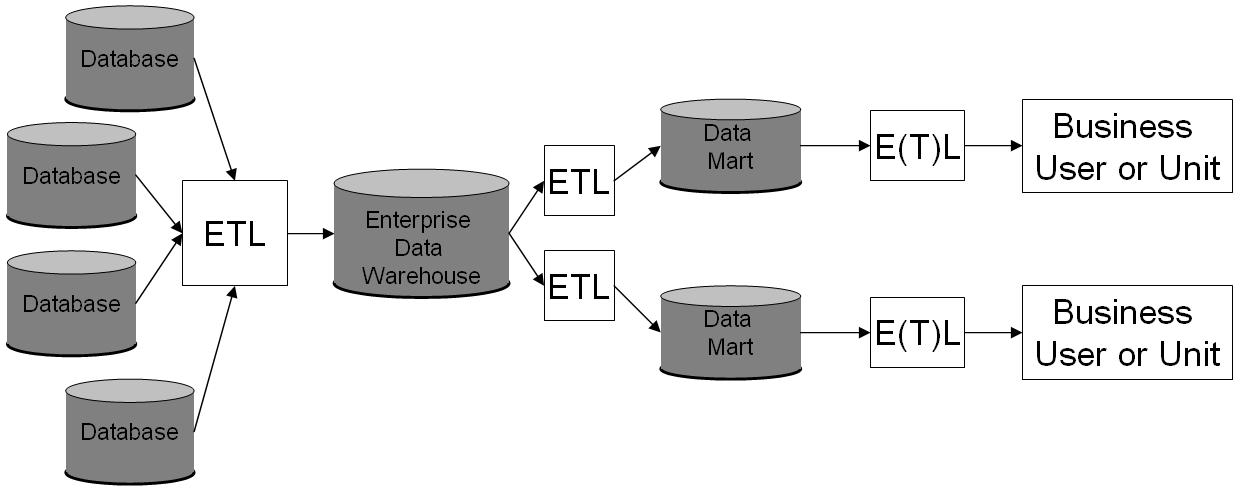|
Information FrameWork
Information FrameWork (IFW) is an enterprise architecture framework, populated with a comprehensive set of banking-specific business models. It was developed as an alternative to the Zachman Framework by Roger Evernden.Information FrameWork ''Systems Journal'' article, Roger Evernden The banking specific s are an extension to the |
Enterprise Architecture Framework
An enterprise architecture framework (EA framework) defines how to create and use an enterprise architecture. An architecture framework provides principles and practices for creating and using the architecture description of a system. It structures architects' thinking by dividing the architecture description into domains, layers, or views, and offers models - typically matrices and diagrams - for documenting each view. This allows for making systemic design decisions on all the components of the system and making long-term decisions around new design requirements, sustainability, and support. Overview Enterprise architecture regards the enterprise as a large and complex system or system of systems. To manage the scale and complexity of this system, an architectural framework provides tools and approaches that help architects abstract from the level of detail at which builders work, to bring enterprise design tasks into focus and produce valuable architecture description doc ... [...More Info...] [...Related Items...] OR: [Wikipedia] [Google] [Baidu] |
Service-oriented Architecture
In software engineering, service-oriented architecture (SOA) is an architectural style that focuses on discrete services instead of a monolithic design. By consequence, it is also applied in the field of software design where services are provided to the other components by application components, through a communication protocol over a network. A service is a discrete unit of functionality that can be accessed remotely and acted upon and updated independently, such as retrieving a credit card statement online. SOA is also intended to be independent of vendors, products and technologies. Service orientation is a way of thinking in terms of services and service-based development and the outcomes of services. A service has four properties according to one of many definitions of SOA: # It logically represents a repeatable business activity with a specified outcome. # It is self-contained. # It is a black box for its consumers, meaning the consumer does not have to be aware of the ser ... [...More Info...] [...Related Items...] OR: [Wikipedia] [Google] [Baidu] |
Product Development
In business and engineering, new product development (NPD) covers the complete process of bringing a new product to market, renewing an existing product or introducing a product in a new market. A central aspect of NPD is product design, along with various business considerations. New product development is described broadly as the transformation of a market opportunity into a product available for sale. The products developed by an organisation provide the means for it to generate income. For many technology-intensive firms their approach is based on exploiting technological innovation in a rapidly changing market. The product can be tangible (something physical which one can touch) or intangible (like a service or experience), though sometimes services and other processes are distinguished from "products". NPD requires an understanding of customer needs and wants, the competitive environment, and the nature of the market. Cost, time, and quality are the main variables that d ... [...More Info...] [...Related Items...] OR: [Wikipedia] [Google] [Baidu] |
Insurance
Insurance is a means of protection from financial loss in which, in exchange for a fee, a party agrees to compensate another party in the event of a certain loss, damage, or injury. It is a form of risk management, primarily used to hedge against the risk of a contingent or uncertain loss. An entity which provides insurance is known as an insurer, insurance company, insurance carrier, or underwriter. A person or entity who buys insurance is known as a policyholder, while a person or entity covered under the policy is called an insured. The insurance transaction involves the policyholder assuming a guaranteed, known, and relatively small loss in the form of a payment to the insurer (a premium) in exchange for the insurer's promise to compensate the insured in the event of a covered loss. The loss may or may not be financial, but it must be reducible to financial terms. Furthermore, it usually involves something in which the insured has an insurable interest established by ... [...More Info...] [...Related Items...] OR: [Wikipedia] [Google] [Baidu] |
Customer Relationship Management
Customer relationship management (CRM) is a process in which a business or other organization administers its interactions with customers, typically using data analysis to study large amounts of information. CRM systems compile data from a range of different communication channels, including a company's website, telephone, email, live chat, marketing materials and more recently, social media. They allow businesses to learn more about their target audiences and how to best cater for their needs, thus retaining customers and driving sales growth. CRM may be used with past, present or potential customers. The concepts, procedures, and rules that a corporation follows when communicating with its consumers are referred to as CRM. This complete connection covers direct contact with customers, such as sales and service-related operations, forecasting, and the analysis of consumer patterns and behaviors, from the perspective of the company. According to Gartner, the global CRM market ... [...More Info...] [...Related Items...] OR: [Wikipedia] [Google] [Baidu] |
Data Warehouse
In computing, a data warehouse (DW or DWH), also known as an enterprise data warehouse (EDW), is a system used for reporting and data analysis and is considered a core component of business intelligence. DWs are central repositories of integrated data from one or more disparate sources. They store current and historical data in one single place that are used for creating analytical reports for workers throughout the enterprise. The data stored in the warehouse is uploaded from the operational systems (such as marketing or sales). The data may pass through an operational data store and may require data cleansing for additional operations to ensure data quality before it is used in the DW for reporting. Extract, transform, load (ETL) and extract, load, transform (ELT) are the two main approaches used to build a data warehouse system. ETL-based data warehousing The typical extract, transform, load (ETL)-based data warehouse uses staging, data integration, and access lay ... [...More Info...] [...Related Items...] OR: [Wikipedia] [Google] [Baidu] |
Service-oriented Architecture
In software engineering, service-oriented architecture (SOA) is an architectural style that focuses on discrete services instead of a monolithic design. By consequence, it is also applied in the field of software design where services are provided to the other components by application components, through a communication protocol over a network. A service is a discrete unit of functionality that can be accessed remotely and acted upon and updated independently, such as retrieving a credit card statement online. SOA is also intended to be independent of vendors, products and technologies. Service orientation is a way of thinking in terms of services and service-based development and the outcomes of services. A service has four properties according to one of many definitions of SOA: # It logically represents a repeatable business activity with a specified outcome. # It is self-contained. # It is a black box for its consumers, meaning the consumer does not have to be aware of the ser ... [...More Info...] [...Related Items...] OR: [Wikipedia] [Google] [Baidu] |
Financial Markets
A financial market is a market in which people trade financial securities and derivatives at low transaction costs. Some of the securities include stocks and bonds, raw materials and precious metals, which are known in the financial markets as commodities. The term "market" is sometimes used for what are more strictly ''exchanges'', organizations that facilitate the trade in financial securities, e.g., a stock exchange or commodity exchange. This may be a physical location (such as the New York Stock Exchange (NYSE), London Stock Exchange (LSE), JSE Limited (JSE), Bombay Stock Exchange (BSE) or an electronic system such as NASDAQ. Much trading of stocks takes place on an exchange; still, corporate actions (merger, spinoff) are outside an exchange, while any two companies or people, for whatever reason, may agree to sell the stock from the one to the other without using an exchange. Trading of currencies and bonds is largely on a bilateral basis, although some bonds trad ... [...More Info...] [...Related Items...] OR: [Wikipedia] [Google] [Baidu] |
Banking Industry
{{set category, first=industries Industry may refer to: Economics * Industry (economics), a generally categorized branch of economic activity * Industry (manufacturing), a specific branch of economic activity, typically in factories with machinery * The wider industrial secto ... (branches of an economy), alternative=industries, topic=Industry (economics) For other meanings of "industries", see :Industries. ... [...More Info...] [...Related Items...] OR: [Wikipedia] [Google] [Baidu] |
Money Laundering
Money laundering is the process of concealing the origin of money, obtained from illicit activities such as drug trafficking, corruption, embezzlement or gambling, by converting it into a legitimate source. It is a crime in many jurisdictions with varying definitions. It is usually a key operation of organized crime. In US law, money laundering is the practice of engaging in financial transactions to conceal the identity, source, or destination of illegally gained money. In UK law the common law definition is wider. The act is defined as "taking any action with property of any form which is either wholly or in part the proceeds of a crime that will disguise the fact that that property is the proceeds of a crime or obscure the beneficial ownership of said property". In the past, the term "money laundering" was applied only to financial transactions related to organized crime. Today its definition is often expanded by government and international regulators such as the US Offi ... [...More Info...] [...Related Items...] OR: [Wikipedia] [Google] [Baidu] |
Data Warehouse
In computing, a data warehouse (DW or DWH), also known as an enterprise data warehouse (EDW), is a system used for reporting and data analysis and is considered a core component of business intelligence. DWs are central repositories of integrated data from one or more disparate sources. They store current and historical data in one single place that are used for creating analytical reports for workers throughout the enterprise. The data stored in the warehouse is uploaded from the operational systems (such as marketing or sales). The data may pass through an operational data store and may require data cleansing for additional operations to ensure data quality before it is used in the DW for reporting. Extract, transform, load (ETL) and extract, load, transform (ELT) are the two main approaches used to build a data warehouse system. ETL-based data warehousing The typical extract, transform, load (ETL)-based data warehouse uses staging, data integration, and access lay ... [...More Info...] [...Related Items...] OR: [Wikipedia] [Google] [Baidu] |
Business Model
A business model describes how an organization creates, delivers, and captures value,''Business Model Generation'', Alexander Osterwalder, Yves Pigneur, Alan Smith, and 470 practitioners from 45 countries, self-published, 2010 in economic, social, cultural or other contexts. The process of business model construction and modification is also called ''business model innovation'' and forms a part of business strategy. In theory and practice, the term ''business model'' is used for a broad range of informal and formal descriptions to represent core aspects of an organization or business, including purpose, business process, target customers, offerings, strategies, infrastructure, organizational structures, sourcing, trading practices, and operational processes and policies including culture. Context The literature has provided very diverse interpretations and definitions of a business model. A systematic review and analysis of manager responses to a survey defines business m ... [...More Info...] [...Related Items...] OR: [Wikipedia] [Google] [Baidu] |






